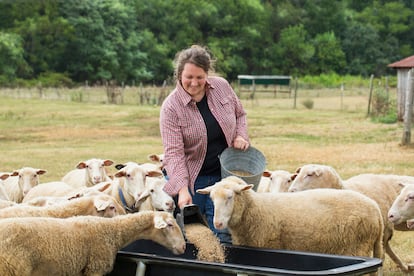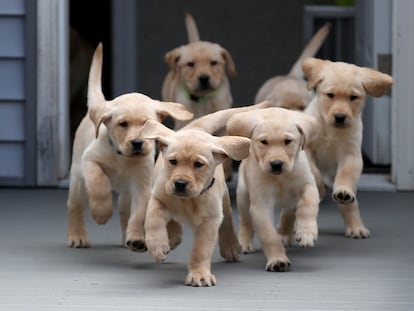Sheep that recognize Emma Watson and dogs that prefer gestures to voices: How do animals understand humans?
After thousands of years coexisting with people, domesticated animals have learned how to recognize us, read our emotions and communicate with us

Domesticated animals encompass a wide variety of species, from clawed predators like cats, to hoofed herbivores like horses. But they all share one common characteristic: they have adapted to humans and the human environment. As a result, these creatures depend on us to survive. We provide them with food, suitable habitats and protection from predators.
This proximity to humans may have led these animals, over millennia, to develop particular cognitive abilities geared specifically towards us. Can animals recognize us individually? Do they perceive human emotions? Do they know when we pay attention to them? How do they communicate with us? These are some of the main questions the scientific community is asking about our four-legged companions. Below, we detail some of the most curious experiments and findings on domesticated mammals.
Sheep that can recognize Emma Watson
In recent years, researchers have conducted numerous studies to determine whether animals can recognize individual humans, whether by voice, smell or face. There is evidence that dogs can identify us by our particular scent, and are even able to distinguish between twins living in the same home. Horses and cats can recognize the voice of a specific person, and dogs, horses and sheep can tell who we are by our faces.
In an experiment at Cambridge University, eight sheep were trained to recognize the faces of Emma Watson and Barack Obama. They were given two black-and-white photographs, one of the celebrity and one of an anonymous person. If they walked to the correct face, they received a reward. With a little practice, the sheep managed to learn to identify both.
One might assume that these animals were merely memorizing the images, not recognizing the faces. But they kept walking towards Emma Watson even when she had a different hairstyle, and even when the pictures were taken from different angles. This suggests that the sheep recognize human faces holistically, as humans do. In real life, sheep are unlikely to be fans of the Harry Potter heroine, but they would undoubtedly recognize the face of their shepherd.
Horses that can smell our emotions
Recent research indicates that some animals can smell human emotions. When we sweat, we excrete different chemicals, like adrenaline, which vary according to our emotional states. Animals that have a very sensitive sense of smell, such as cows and horses, can pick up on these differences.
For example, in one study, scientists collected sweat from several human volunteers as the subjects were watching a horror movie, and when they were watching a light-hearted cartoon. The researchers then presented the sweat samples to 21 horses, and measured the animals’ reactions. With the fear samples, the horses would raise their heads and seek out a familiar person, but when they smelled the happy samples, the horses would lower their heads and appear relaxed.
Several species, such as goats, horses and dogs, have also been shown to perceive human emotions through facial expressions. The most widely accepted explanation for this is that, in response to our emotions, domestic animals experience what is known as “emotional contagion,” which is considered a primitive form of empathy.
Pigs that can tell who is paying attention to them
Domesticated animals are often dependent on humans for access to the resources they require for survival. This is why it would be important for them to know how to identify a particular human who is most likely to give them what they need. Several studies indicate that certain domesticated animals use eye contact as a determining clue.
Scientists at Martin-Luther University in Germany wondered whether pigs might be able to detect when a human is paying attention to them. Conducting an experiment, they found that these animals preferred to approach a researcher whose head was facing them, as opposed to a person who had their head turned away. This preference, however, only occurred when the pigs’ movements were slow and calm, and not when they were acting impulsively.
Dogs that focus on our gestures
Anyone who has lived long enough with a dog knows that they are capable of understanding our words and gestures. We can train them to sit, lie down, or approach when we ask them to. But what happens if we use contradictory signals? That is, if we make the “come” gesture but tell them to sit down. At the University of Naples, researchers found that most dogs prioritize obeying gestures, suggesting that for these animals, visual information is more important than auditory information.
In fact, scientists have studied in some detail whether domesticated animals can understand the human gesture of pointing. Cats, dogs, ferrets, goats and pigs have all been tested, with mixed results. Dogs understand the gesture the best, while goats and pigs are less likely to recognize it.
Goats that communicate with their eyes
Domesticated animals use a variety of signals to communicate with the humans on whom they depend. Cats have a distinct purr they use when they want to solicit their owner’s cuddles; dogs modify their facial expressions when they notice that we are paying attention to them; and horses, dogs and goats use their eyes to get what they want.
At Queen Mary University of London, goats were given an impossible task: researchers placed food under a transparent plastic box that was glued to the floor, and let the goats try to get it. At first, the goats would try to lift the box, to no avail. But if the experimenter was watching, the goats would repeatedly alternate their gaze between the box and the experimenter, as if to say “excuse me, I need help with this.” They did not exhibit this behavior if the researcher was looking away, suggesting that the goats were attempting to communicate.
The science studying the relationship between domesticated animals and humans is still in its early stages. There are some animals, such as donkeys and rabbits, about which we have hardly any information at all. There may also be many wild animals that, if we were to study them, would also exhibit an ability to recognize human faces, emotions and gestures, if they were to spend time around humans.
One key question remains unresolved: is it domestication that has endowed certain animals with these cognitive abilities, or did humans choose these species precisely because they exhibited such abilities?
Sign up for our weekly newsletter to get more English-language news coverage from EL PAÍS USA Edition
Tu suscripción se está usando en otro dispositivo
¿Quieres añadir otro usuario a tu suscripción?
Si continúas leyendo en este dispositivo, no se podrá leer en el otro.
FlechaTu suscripción se está usando en otro dispositivo y solo puedes acceder a EL PAÍS desde un dispositivo a la vez.
Si quieres compartir tu cuenta, cambia tu suscripción a la modalidad Premium, así podrás añadir otro usuario. Cada uno accederá con su propia cuenta de email, lo que os permitirá personalizar vuestra experiencia en EL PAÍS.
¿Tienes una suscripción de empresa? Accede aquí para contratar más cuentas.
En el caso de no saber quién está usando tu cuenta, te recomendamos cambiar tu contraseña aquí.
Si decides continuar compartiendo tu cuenta, este mensaje se mostrará en tu dispositivo y en el de la otra persona que está usando tu cuenta de forma indefinida, afectando a tu experiencia de lectura. Puedes consultar aquí los términos y condiciones de la suscripción digital.
More information
Archived In
Últimas noticias
Susan Boyle prepares a comeback just as Timothée Chalamet sings her praises
Trump suspends green card visa lottery after shooting at Brown University
When things get out of hand at the lab: Hundreds of accidents expose the ‘catastrophic’ risk of dangerous pathogen leaks
Venezuelan migrants contribute billions of dollars to Latin America, but continue to work in the informal sector
Most viewed
- Christian Louboutin: ‘Young people don’t want to be like their parents. And if their parents wear sneakers, they’re going to look for something else’
- Cartels in Mexico take a leap forward with narco-drones: ‘It is criminal groups that are leading the innovation race’
- Liset Menéndez de la Prida, neuroscientist: ‘It’s not normal to constantly seek pleasure; it’s important to be bored, to be calm’
- ‘El Limones’ and the growing union disguise of Mexican organized crime
- The low-cost creative revolution: How technology is making art accessible to everyone











































